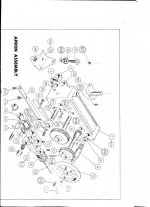Grizzler73
Plastic
- Joined
- Mar 19, 2019
Hi All
I have just joined the forum as I recently bought a Mk1 (1953/54) Imperial Colchester Student. This will probably be the first of many basic question posts!
I have replaced the motor and added a VFD but I am having trouble engaging the sliding/surfacing feed, it will go into sliding feed only moving away from the chuck and when engaged in surfacing it just clicks and feels like something is worn or misaligned.
Does anyone have a diagram of this type of apron? I can only find the later plunger type.
The other issue I have is that the levers on top that change the gears seem to easily drop out of engagement, even under no load, is there something I can adjust to fix that?
Thanks in advance for any help.
Simon
I have just joined the forum as I recently bought a Mk1 (1953/54) Imperial Colchester Student. This will probably be the first of many basic question posts!
I have replaced the motor and added a VFD but I am having trouble engaging the sliding/surfacing feed, it will go into sliding feed only moving away from the chuck and when engaged in surfacing it just clicks and feels like something is worn or misaligned.
Does anyone have a diagram of this type of apron? I can only find the later plunger type.
The other issue I have is that the levers on top that change the gears seem to easily drop out of engagement, even under no load, is there something I can adjust to fix that?
Thanks in advance for any help.
Simon


